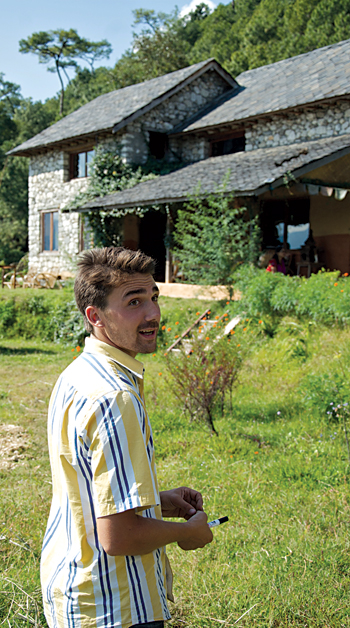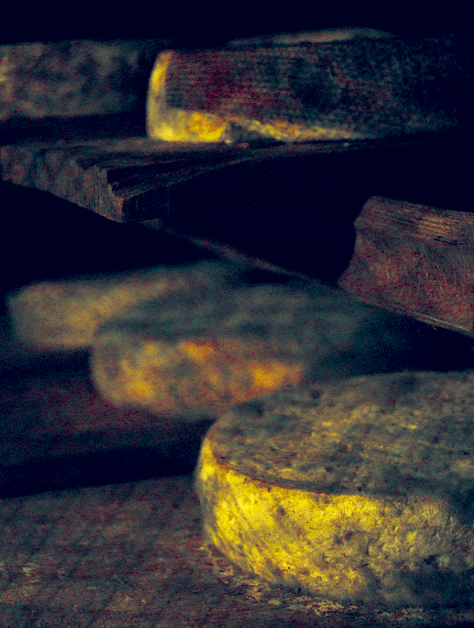Cheese, wine, and a friend must be old to be good.” This old Cuban proverb is one of François Driard’s favorites.
 The Himalayan French Cheese co-founder has an interesting take on the issue of cheese and friends. For someone with a cheese obsession as acute as his, you would think perhaps he would have a favorite.
The Himalayan French Cheese co-founder has an interesting take on the issue of cheese and friends. For someone with a cheese obsession as acute as his, you would think perhaps he would have a favorite.
“I don’t have a favorite cheese, no. I mean it’s like asking who is my best friend? I don’t have one. I like many cheeses the same for their qualities, much like I like many friends for their qualities.”
Lucky friends.
But, unlike the proverb, cheese doesn’t necessarily have to be old to be good as evidenced by the company’s bestseller, the Tomme de Savoie, taking just one month to mature.
When you first meet Driard, you’re immediately taken with his energy and enthusiasm, particularly impressive given how hard the man works. He has all the charm of a French country boy, the only difference being his country of choice is Nepal, not France.
It may come as a surprise, especially after you’ve become deliciously acquainted with his cheeses, he has only held his knowledge of the tricky process behind cheese-making for a mere few years. In fact, living and working in Nepal on a cheese farm was never part of Driard’s original plan. “I was a city guy, like you!” Hailing from the land of fine cheeses the 31-year-old has a background in business studies and journalism, a far cry from the farm life he has settled into now.
When Driard hit Nepal, he immediately fell in love with the country.
“I came in Nepal in 1996 for the first time for tourism and was quickly struck by the harmony of the people, the landscape, the nature, and the climate. I loved the monsoon which remains my favorite season. Just the year before, in 1995, I had gone to do volunteering in Mali and had loved it that too, but Kathmandu’s architecture, and the smiles of people touched me even more. I might still go and build a farm in Mali one day though.”
Besides the sultry monsoon months, he even liked yak cheese… to a certain extent. However, the one thing he missed from his homeland was the range of beautiful cow milk cheeses he wasn’t able to find in the Himalayas. One day, during a trip to Bhat-Bhateni supermarket, he noticed some fruit juice from South Africa and wondered why, when Nepal with rich resources of its own, someone hadn’t taken it upon themselves to make French produce?
So, being the resourceful and driven fellow he is, he thought - why not make his own?
“I want to make meat and cheese because that’s all I eat. I don’t do veg,” he says with a highly contagious grin, which has been his ticket out of many a sticky situation.
On December 15, 2007, Driard produced his first cheese. Exactly one month after maturing in the ‘cave’, this cheese was sold. As previously mentioned, one of the many advantages of the cheese is its short maturation time, each disc of Tomme de Savoie being ready for the platter after just one month. But when you taste Himalayan French Cheese, this swiftness is not at all apparent. On the palate, the cheese tastes much more matured. Semi-firm in its texture, the Tomme de Savoie gets its name from its origin in the valley of the Savoie in the French Alps. Driard modestly says it is an easy cheese to make, but when he explains the process it doesn’t seem quite so.
“We have to worry about bacteria. I make this cheese as it only takes an hour or so to make, from milk to mould. So there’s no chance for bacteria to invade. First we milk the cows, then we mix with milk from the night before along with the rennet and some curd, leave it for 35 minutes, cut it, mix again, then put it in the mould. We turn it every two hours to expel the whey, salt it once on one side then salt it again on the other 24 hours later.”
From this point on, the cheese takes 30 days to mature in the farm’s moist, temperature-controlled cave.
“The cave is naturally cold during the winter, but we have to put AC in it during the summer. We will build the next farm’s cave deeper underground.”
Due to the careful control of the humidity, a fine fungus forms on each cheese, which is brushed every two days, taking on the tiny cave’s unique aroma to form a thick, hard rind.
Of the rind, Driard prefers to eat this along with the cheese. “Yeah, some people say to eat the rind takes away the flavor from the cheese, but I like it.”
He would like to produce good quality Parmigiano Reggiano one day (a hard, aromatic cheese that takes a whopping 16 liters of cow’s milk to produce one kilo of cheese), yet with each batch taking three years to reach maturation, he believes he’s not quite patient enough for that yet.
“I would also like to try to make the Vacherin Mont d’Or one day,” he says as he opens one of his many cheese-making books and points out the cheese in question.
“It’s so soft, you open the rind and spread it on bread like a fondue.” Sounds like the sort of devilishly decadent cheese that would be enough to put a twinkle in the eyes of even those suffering severe lactose-intolerance.
 But given Nepal’s electricity shortage and the extended period the cheese takes between milk and mould (compared with the Tomme), he is doubtful it will be possible to avoid exposing the cheese to airborne bacteria at present. But the charismatic Driard has enough Gallic charm to achieve just about anything he sets his mind to.
But given Nepal’s electricity shortage and the extended period the cheese takes between milk and mould (compared with the Tomme), he is doubtful it will be possible to avoid exposing the cheese to airborne bacteria at present. But the charismatic Driard has enough Gallic charm to achieve just about anything he sets his mind to.
Depending on demand, however, Himalayan French Cheese occasionally releases rare Old Reserve Nepali
Cheese, matured for a longer period yet priced only slightly higher than its younger counterpart.
Driard has also recently returned from a two month sojourn to France to learn more about cheese and sausage and has now expanded his repertoire to include three new cheeses and two sausages.
The Saint Marcellin (or ‘petit’ cheese) is a soft, un-pressed cheese originating from France’s Dauphiné region. Another sure triumph-in-the-making is the Saint Nectaire, a hard, semi-pressed cheese which takes on a subtle spice and nutty flavor. Also on the market is a range of spreadable ricottas, as well as wet and dry pork sausages.
Whichever cheese you choose, it goes without saying Driard’s is the only cheese of its kind in Nepal. Though he plans to produce even more varieties of French cheese in the future (maybe even the ubiquitous Parmigiano Reggiano), Himalayan French Cheese is doing roaring business at the moment, its clientele including the European Bakery (Baluwatar), Chez Caroline (Baber Mahal), Nina & Hager (Jawalakhel), Hermann Helmers (Jhamsikhel), as well as feeding the happy bellies of the French Embassy’s fortunate staff. Top-end hotels such as Hyatt, Dwarika and Gokarna’s former Le Meridien also feature it on their breakfast buffet.
To try before you buy, head to the organic market in Summit Hotel’s idyllic gardens on a Sunday morning, wherein Driard or his super-hospitable partner in cheese, Binod Neupane, will offer you a slice atop freshly-baked bread. Like the way your taste buds react? Buy as little or as much as you like.
So how does Driard see the future of Himalayan French Cheese? Like everyone in Nepal, and indeed the world, money has been tight during this stiff global economic crisis. And he’s also restricted by a particularly nasty strain of ‘Catch-22’ in business, you need to spend money to make money. First, he plans to expand to provide his existing cows with more grassland on which to graze the day away. A happy cow is a productive cow. But with the price of property in Nepal increasing almost as rapidly as the temperature decreases in the lead-up to the chilly winter months, he is having difficulty finding a suitable plot.
But where there’s a will, there’s a way. And if anyone can find a way, it’s Driard.
In the meantime, the farm he, his partners and host of workers built from scratch is just beautiful. Home to 90-plus animals, the farm is a menagerie to say the least. Besides cows, geese, ducks, lambs, pigs, dogs, rabbits, chickens and a cat, birds and all manner of creepy-crawlies help make up the harmonious eco-system. A modern day Noah’s ark, even those animals whose procreation does not directly affect the running of the farm and its financial gains have at least one counterpart of the opposite sex. In fact, at the time of interview, Driard was currently seeking a ‘girlfriend’ for his dog – wild, but loyal and loving regardless. He is an animal-lover and strongly belives that each animal should be paired up, “Just like people, you know?” That being said, just like a carefully arranged marriage, he won’t settle for just any old dog and had interviewed several ‘maybes’, waiting for just the right one to come along for his best friend. Once he has shifted to the new plot, control of his existing farm will be turned over to his equally driven sister, Pauline, who plans to host visitors, bed-and-breakfast style, in the magical location overlooking the Kathmandu Valley.Located on a hillside in Tokha, Chandeswhori (north of the Ring Road), the farm is humble, with a country charm that could place it in Nepal or France. Visitors are struck by the tranquility of the place, close, yet a world away from the chaos and traffic of Kathmandu. Finding the farm is a bit tricky and best left to Driard to explain. Visitors are welcome, a tour and tasting costing around Rs 1,000. But be warned, there are no direct roads, and getting there involves a 10-minute climb on a steep and narrow path through dense forest leaping across streams and scaling rocky outcrops.The nimble Driard has made the journey hundreds of times and navigates the path easily. He does so with the aforementioned eternal energy and enthusiasm, also apparent in his love for his Nepalese home - his own slice of heaven.
For more about Himalayan French Cheese and Pauline’s Guesthouse, log on to http://himalayanfrenchcheese.com and http://paulinesguesthouse.com.
The author is a freelance writer living in Kathmandu. Email miriam.fisher@hotmail.com.









